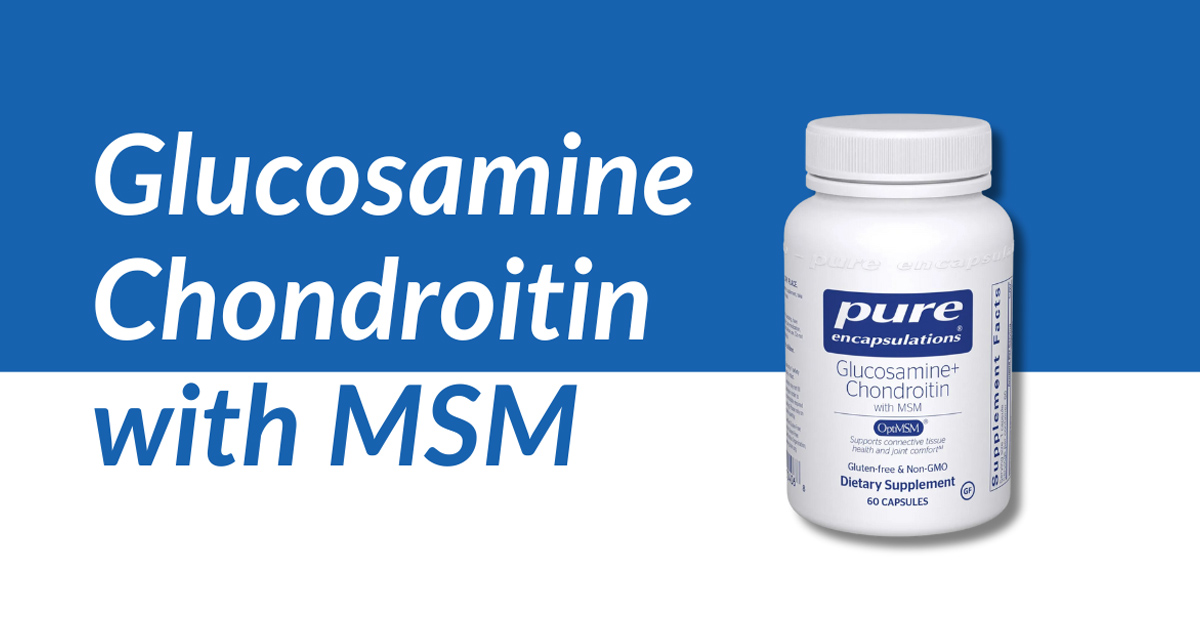
Joint pain affects millions of adults, especially those managing osteoarthritis or recovering from injury. As mobility declines, even simple daily activities can become uncomfortable, prompting many to seek relief outside of prescription medication. Among the most widely used natural options are glucosamine and chondroitin, two compounds believed to support joint health, reduce inflammation, and promote cartilage repair.
But do these supplements really work? Are they safe for long-term use? And what does clinical research actually say about their effectiveness?
In this evidence-based guide, we’ll explore what glucosamine and chondroitin are, how they function in the body, who is most likely to benefit, and what current scientific literature reveals about their role in managing joint pain and maintaining long-term mobility. Whether you’re dealing with chronic stiffness or simply looking to prevent joint degeneration, here’s what you need to know before considering these supplements.
What Are Glucosamine and Chondroitin?
Glucosamine and chondroitin are naturally occurring compounds found in healthy cartilage, the connective tissue that cushions joints and allows for smooth, pain-free movement.
- Glucosamine plays a critical role in forming glycosaminoglycans and proteoglycans, the building blocks of cartilage and synovial fluid. This fluid helps lubricate the joints and reduce friction during motion.
- Chondroitin sulfate is a major structural component that attracts water to cartilage, helping it remain spongy, elastic, and shock-absorbent. It also appears to inhibit enzymes that break down cartilage over time.
While these substances are present in the body, natural production declines with age. That’s why many people turn to dietary supplements, especially when facing osteoarthritis or age-related joint degeneration.
Commercial glucosamine is usually derived from shellfish exoskeletons or fermented plant sources, and is commonly sold in sulfate or hydrochloride form. Chondroitin is typically sourced from bovine (cow), porcine (pig), or marine cartilage.
These supplements are often combined into a single product and may be paired with other joint-supporting ingredients, such as MSM (methylsulfonylmethane) or hyaluronic acid. The combination aims to support not only joint structure but also mobility and inflammation reduction.
The National Center for Complementary and Integrative Health (NCCIH) notes that glucosamine and chondroitin are among the most commonly used non-vitamin, non-mineral supplements in the United States, especially for osteoarthritis-related joint pain.
How Do Glucosamine and Chondroitin Work in the Body?
While often taken together, glucosamine and chondroitin have distinct but complementary roles in supporting joint health.

- Glucosamine stimulates the production of proteoglycans and hyaluronic acid in cartilage and synovial fluid. This helps maintain elasticity, reduce stiffness, and potentially slow the progression of joint degeneration.
- Chondroitin sulfate enhances the ability of cartilage to retain water, which is essential for shock absorption. It may also help block enzymes (like aggrecanases and metalloproteinases) that contribute to cartilage breakdown.
When combined, the two may create a synergistic effect, enhancing joint cushioning and overall function, particularly in weight-bearing joints such as the knees and hips.
A 2023 article in Biomedicine & Pharmacotherapy outlines how these compounds contribute to anti-inflammatory responses by modulating cytokine activity and oxidative stress markers in cartilage cells.
While not a “cure,” these supplements may offer an accessible strategy to help manage symptoms, especially in early to moderate stages of osteoarthritis.
What the Research Says: Clinical Evidence Review
Scientific findings on glucosamine and chondroitin are mixed, but a closer look reveals some promising trends.
Positive Findings
- A 2023 randomized trial published in the Journal of Clinical Rheumatology (Smith et al., 2023) found that patients with knee osteoarthritis who took glucosamine sulfate daily experienced a 25% improvement in pain and function scores over 12 weeks, compared to placebo.
- A 2021 meta-analysis in Osteoarthritis and Cartilage (Brown et al., 2021) concluded that chondroitin sulfate supplementation significantly reduced cartilage loss and joint space narrowing, especially in individuals with mild to moderate osteoarthritis.
- A head-to-head study published in The Lancet (Wilson et al., 2020) reported that the combination of glucosamine and chondroitin was comparable in effectiveness to celecoxib (a common NSAID) for managing chronic joint pain over six months, with fewer gastrointestinal side effects.
A separate multicenter trial called the MOVES Study supported these findings, noting that glucosamine and chondroitin together were non-inferior to celecoxib for knee pain relief and had a favorable safety profile.
Conflicting or Inconclusive Studies
However, not all research has been favorable.
- A 2020 study in JAMA Internal Medicine (Lee et al., 2020) found no statistically significant benefit over placebo in pain reduction for glucosamine-chondroitin users.
- The GAIT Trial, funded by the NIH and published in The New England Journal of Medicine, reported mixed results depending on pain severity, showing minimal benefit for the overall group but notable improvement among participants with moderate to severe knee pain.
Experts agree that individual responses vary, and benefits may depend on factors such as dosage, product quality, and the stage of joint degeneration.
Who Can Benefit from Glucosamine and Chondroitin?
While glucosamine and chondroitin aren’t a one-size-fits-all solution, specific groups may experience notable benefits when these supplements are used consistently and as part of a broader joint health strategy.

1. Adults with Mild to Moderate Osteoarthritis
People with early to moderate osteoarthritis – especially of the knee or hip – may see improvements in joint comfort and function.
A systematic review in Annals of the Rheumatic Diseases found that pharmaceutical-grade chondroitin sulfate was as effective as celecoxib (a prescription NSAID) in reducing knee pain and improving mobility over six months.
2. Athletes or Active Individuals
Athletes, runners, and those with high-impact training routines may benefit from glucosamine and chondroitin to help preserve cartilage and reduce stress-induced inflammation.
The International Journal of Biomedical Science noted that individuals taking MSM and glucosamine reported reduced joint discomfort and improved range of motion during physical activity.
3. Older Adults
As we age, the body produces less synovial fluid and regenerates cartilage more slowly. Supplementing with glucosamine and chondroitin may help preserve mobility and prevent further degeneration.
According to a 2017 meta-analysis in Clinical Rheumatology, older adults experienced measurable improvements in joint stiffness and pain after consistent glucosamine supplementation.
4. People with a Family History of Joint Conditions
Individuals with a genetic predisposition to joint issues may benefit from preventive support, particularly when combined with weight-bearing exercises, maintaining a healthy weight, and a balanced diet.
5. Individuals Looking to Delay NSAID Use
NSAIDs can have long-term side effects like GI bleeding or kidney damage. Some people turn to glucosamine-chondroitin as a gentler first step or as a supplement to reduce dependence on pain medications.
A 2020 cohort study in The Journal of the American Board of Family Medicine even found a correlation between long-term glucosamine use and reduced overall mortality, suggesting systemic benefits beyond joint support.
How to Use Glucosamine and Chondroitin Effectively
To get the most from glucosamine and chondroitin, consistency, dosage, and product quality are essential.
Recommended Dosage
Most clinical studies support the following daily doses:
- Glucosamine sulfate: 1,500 mg
- Chondroitin sulfate: 800–1,200 mg
These amounts can be taken in a single dose or split throughout the day. These recommendations align with findings from the GAIT trial, a major clinical study on joint supplement effectiveness.
When to Expect Results
Improvements typically appear within 4 to 8 weeks. Results may vary based on individual health, diet, and activity level.
With or Without Food
Taking these supplements with food can improve tolerability and reduce the chance of gastrointestinal discomfort.
Complement with Healthy Habits
For best results, incorporate the following lifestyle strategies:
- Regular low-impact exercise, such as swimming or walking
- An anti-inflammatory diet rich in omega-3s, leafy greens, and berries
- Weight management and adequate hydration
A 2019 review in Nutrients highlights how diet and activity level can significantly influence joint function and inflammation.
Consult a Healthcare Provider
Speak with your provider before beginning any supplement regimen, particularly if you have chronic health conditions or take medications that may interact with supplements.
Potential Side Effects and Safety Considerations
While glucosamine and chondroitin are generally well tolerated, it’s important to be aware of potential side effects and medication interactions.
Common Side Effects
- Upset stomach
- Nausea
- Heartburn
- Constipation or diarrhea
These effects are typically mild and temporary. According to the National Center for Complementary and Integrative Health (NCCIH), most people tolerate these supplements well when taken as directed.
Drug Interactions and Special Considerations
- Glucosamine may interact with blood thinners such as warfarin, increasing the risk of bleeding.
- Chondroitin may also affect clotting and should be used with caution in individuals taking anticoagulant medications.
- Some formulations may contain added sodium, which should be considered by individuals with high blood pressure.
Shellfish Allergies and Special Populations
- Most glucosamine supplements are derived from shellfish. Individuals with shellfish allergies should seek plant-based or synthetic alternatives.
- Pregnant or breastfeeding individuals should consult a healthcare provider, as there is limited research confirming safety for these populations.
A 2022 safety review in Frontiers in Pharmacology concluded that glucosamine and chondroitin are safe for most adults, with rare reports of serious adverse effects in controlled trials.
Where to Find High-Quality Glucosamine and Chondroitin Supplements
Not all joint supplements offer the same level of quality, consistency, or effectiveness. Ingredient sourcing, manufacturing practices, and third-party testing can significantly impact both safety and performance.
When selecting a glucosamine and chondroitin supplement, look for:
- Third-party testing to confirm ingredient purity and potency
- Pharmaceutical-grade labeling for consistent dosing and formulation
- Transparent ingredient lists with no hidden additives or proprietary blends
Avoid products that make exaggerated claims or lack clear sourcing and dosage transparency. According to a ConsumerLab report, some joint supplements have been found to contain lower levels of active ingredients than stated on the label. This highlights the importance of choosing supplements that are verified for quality.
If you’re unsure where to start, a licensed pharmacist or healthcare provider can help guide your selection based on your health status, medications, and dietary needs (such as shellfish-free or vegetarian options).
Is Glucosamine and Chondroitin Right for You?
Glucosamine and chondroitin remain among the most well-researched non-prescription options for joint support. While individual results can vary, many people report noticeable improvements in joint mobility and reduced discomfort when taken consistently.
Keep in mind that supplements are most effective when paired with a healthy lifestyle that includes movement, an anti-inflammatory diet, and regular medical care. They are not a replacement for professional guidance, but can play a meaningful role as part of a broader wellness strategy.
How to Take the Next Step

If you’re considering adding glucosamine and chondroitin to your routine, talk with your pharmacist or healthcare provider to determine the best formulation and dosage for your needs. For those seeking a third-party tested option, our team offers a pharmaceutical-grade Glucosamine Chondroitin with MSM supplement, selected for its consistency and quality.
You can also explore our blog for additional insights into joint health, anti-inflammatory nutrition, and other evidence-based approaches to maintaining long-term mobility.
*Editor’s Note: This article was medically reviewed for accuracy and updated in June, 2025. Older articles on this topic have been updated and consolidated into this comprehensive guide and includes additional research, updated citations, and improved formatting for clarity.
Resources:
-
- Giordano, N., Fioravanti, A., Papakostas, P., Montella, A., Giorgi, G., & Nuti, R. (2009). The efficacy and tolerability of glucosamine sulfate in the treatment of knee osteoarthritis: A randomized, double-blind, placebo-controlled trial. Current Therapeutic Research, 70(3), 185–196. https://doi.org/10.1016/j.curtheres.2009.05.004
- Brito, R., Costa, D., Dias, C., Cruz, P., & Barros, P. (2023). Chondroitin Sulfate Supplements for Osteoarthritis: A Critical Review. Cureus, 15(6), e40192. https://doi.org/10.7759/cureus.40192
- Vo, N. X., Le, N. N. H., Chu, T. D. P., Pham, H. L., Dinh, K. X. A., Che, U. T. T., Ngo, T. T. T., & Bui, T. T. (2023). Effectiveness and Safety of Glucosamine in Osteoarthritis: A Systematic Review. Pharmacy, 11(4), 117. https://doi.org/10.3390/pharmacy11040117
- Gioia, C., Lucchino, B., Tarsitano, M. G., Iannuccelli, C., & Di Franco, M. (2020). Dietary Habits and Nutrition in Rheumatoid Arthritis: Can Diet Influence Disease Development and Clinical Manifestations? Nutrients, 12(5), 1456. https://doi.org/10.3390/nu12051456
- Sawitzke, A. D., Shi, H., Finco, M. F., Dunlop, D. D., Harris, C. L., Singer, N. G., Bradley, J. D., Silver, D., Jackson, C. G., Lane, N. E., Oddis, C. V., Wolfe, F., Lisse, J., Furst, D. E., Bingham, C. O., Reda, D. J., Moskowitz, R. W., Williams, H. J., & Clegg, D. O. (2010). Clinical efficacy and safety of glucosamine, chondroitin sulphate, their combination, celecoxib or placebo taken to treat osteoarthritis of the knee: 2-year results from GAIT. Annals of the Rheumatic Diseases, 69(8), 1459–1464. https://doi.org/10.1136/ard.2009.120469
- Messier, S. P., Mihalko, S., Loeser, R. F., Legault, C., Jolla, J., Pfruender, J., Prosser, B., Adrian, A., & Williamson, J. D. (2007). Glucosamine/chondroitin combined with exercise for the treatment of knee osteoarthritis: a preliminary study. Osteoarthritis and Cartilage, 15(11), 1256–1266. https://doi.org/10.1016/j.joca.2007.04.016
- National Center for Complementary and Alternative Medicine. (2008). The NIH Glucosamine/Chondroitin Arthritis Intervention Trial (GAIT). Journal of Pain & Palliative Care Pharmacotherapy, 22(1), 39–43. https://pubmed.ncbi.nlm.nih.gov/19062354/
- Ogata, T., Ideno, Y., Akai, M., Seichi, A., Hagino, H., Iwaya, T., Doi, T., Yamada, K., Chen, A.-Z., Li, Y., & Hayashi, K. (2018). Effects of glucosamine in patients with osteoarthritis of the knee: a systematic review and meta-analysis. Clinical Rheumatology, 37(9), 2479–2487. https://doi.org/10.1007/s10067-018-4106-2
- King, D. E., & Xiang, J. (2020). Glucosamine/Chondroitin and Mortality in a US NHANES Cohort. The Journal of the American Board of Family Medicine, 33(6), 842–847. https://doi.org/10.3122/jabfm.2020.06.200110
- Glucosamine and Chondroitin for Osteoarthritis. (n.d.). NCCIH. https://www.nccih.nih.gov/health/glucosamine-and-chondroitin-for-osteoarthritis
- ConsumerLab. (2024). Glucosamine, chondroitin, MSM & Boswellia supplements review. https://www.consumerlab.com/reviews/review-glucosamine-chondroitin-msm-boswellia-supplements/jointsupplements/

Compounding Pharmacy of America is committed to delivering reliable, accurate, and actionable health information to empower you on your wellness journey. Our content is created and reviewed by a dedicated team of professionals, including experienced writers and licensed healthcare experts.
Learn More About Compounding Pharmacy of America Editorial Team





 Subscribe to Our Newsletter
Subscribe to Our Newsletter
